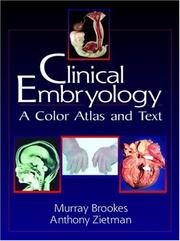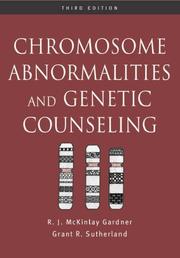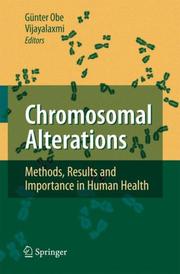| Listing 1 - 10 of 31 | << page >> |
Sort by
|

ISBN: 0849312558 Year: 1998 Publisher: Boca Raton, FL : CRC Press [Chemical Rubber Company],
Abstract | Keywords | Export | Availability | Bookmark
 Loading...
Loading...Choose an application
- Reference Manager
- EndNote
- RefWorks (Direct export to RefWorks)
Human embryology --- Embryology --- Embryology. --- Embryology, Human --- Human embryo --- Embryologie humaine --- Atlases. --- Diseases --- Abnormalities --- Atlas --- Chromosomal abnormality
Multi
ISBN: 9069000113 Year: 1992 Publisher: Leiden
Abstract | Keywords | Export | Availability | Bookmark
 Loading...
Loading...Choose an application
- Reference Manager
- EndNote
- RefWorks (Direct export to RefWorks)
Axons --- Hair --- Hereditary Sensory and Motor Neuropathy --- Retrograde Degeneration --- Chromosome Aberrations. --- Abnormalities, Autosome --- Abnormalities, Chromosomal --- Abnormalities, Chromosome --- Chromosomal Aberrations --- Chromosome Abnormalities --- Cytogenetic Abnormalities --- Autosome Abnormalities --- Cytogenetic Aberrations --- Aberration, Chromosomal --- Aberration, Chromosome --- Aberration, Cytogenetic --- Aberrations, Chromosomal --- Aberrations, Chromosome --- Aberrations, Cytogenetic --- Abnormalities, Cytogenetic --- Abnormality, Autosome --- Abnormality, Chromosomal --- Abnormality, Chromosome --- Abnormality, Cytogenetic --- Autosome Abnormality --- Chromosomal Aberration --- Chromosomal Abnormalities --- Chromosomal Abnormality --- Chromosome Aberration --- Chromosome Abnormality --- Cytogenetic Aberration --- Cytogenetic Abnormality --- Chromosomes --- Cytogenetics --- Genetics, Medical --- Cytogenetic Analysis --- ultrastructure. --- abnormalities. --- genetics. --- abnormalities --- Theses --- Chromosome Aberrations --- ultrastructure --- genetics
Periodical
Abstract | Keywords | Export | Availability | Bookmark
 Loading...
Loading...Choose an application
- Reference Manager
- EndNote
- RefWorks (Direct export to RefWorks)
Genetics --- Genomes --- Genome --- Periodicals. --- periodicals. --- Genomics --- Mutation (Biology) --- Génétique --- Génome humain --- Research --- Biology --- Embryology --- Mendel's law --- Adaptation (Biology) --- Breeding --- Chromosomes --- Heredity --- Variation (Biology) --- Genes --- Proteome --- Genetic Structures --- Genetic Phenomena --- Chromosome Aberrations. --- Mutation. --- Abnormalities, Autosome --- Abnormalities, Chromosomal --- Abnormalities, Chromosome --- Chromosomal Aberrations --- Chromosome Abnormalities --- Cytogenetic Abnormalities --- Autosome Abnormalities --- Cytogenetic Aberrations --- Aberration, Chromosomal --- Aberration, Chromosome --- Aberration, Cytogenetic --- Aberrations, Chromosomal --- Aberrations, Chromosome --- Aberrations, Cytogenetic --- Abnormalities, Cytogenetic --- Abnormality, Autosome --- Abnormality, Chromosomal --- Abnormality, Chromosome --- Abnormality, Cytogenetic --- Autosome Abnormality --- Chromosomal Aberration --- Chromosomal Abnormalities --- Chromosomal Abnormality --- Chromosome Aberration --- Chromosome Abnormality --- Cytogenetic Aberration --- Cytogenetic Abnormality --- Cytogenetics --- Genetics, Medical --- Cytogenetic Analysis --- Mutations --- DNA Damage --- Polymorphism, Restriction Fragment Length --- abnormalities
Book
ISBN: 2738000932 9782738000934 Year: 1989 Publisher: Paris : INRA,
Abstract | Keywords | Export | Availability | Bookmark
 Loading...
Loading...Choose an application
- Reference Manager
- EndNote
- RefWorks (Direct export to RefWorks)
Mammifère --- mammals --- Animal domestique --- domestic animals --- Cytogénétique --- cytogenetics --- Carte génétique --- genetic maps --- chromosomes --- Chèvre --- Nannygoats --- Mouton --- Wethers --- Bovin --- Cattle --- Porcin --- Swine --- Cheval --- horses --- Animals, Domestic --- Chromosome Aberrations. --- #ABIB:aimm --- Abnormalities, Autosome --- Abnormalities, Chromosomal --- Abnormalities, Chromosome --- Chromosomal Aberrations --- Chromosome Abnormalities --- Cytogenetic Abnormalities --- Autosome Abnormalities --- Cytogenetic Aberrations --- Aberration, Chromosomal --- Aberration, Chromosome --- Aberration, Cytogenetic --- Aberrations, Chromosomal --- Aberrations, Chromosome --- Aberrations, Cytogenetic --- Abnormalities, Cytogenetic --- Abnormality, Autosome --- Abnormality, Chromosomal --- Abnormality, Chromosome --- Abnormality, Cytogenetic --- Autosome Abnormality --- Chromosomal Aberration --- Chromosomal Abnormalities --- Chromosomal Abnormality --- Chromosome Aberration --- Chromosome Abnormality --- Cytogenetic Aberration --- Cytogenetic Abnormality --- Chromosomes --- Cytogenetics --- Genetics, Medical --- Cytogenetic Analysis --- genetics. --- abnormalities --- Domestic animals --- Veterinary genetics --- Animaux domestiques --- Génétique vétérinaire --- Chromosome Aberrations --- genetics --- Animaux domestiques - Cytogénétique --- Inra --- Mammifere d'elevage --- Carte genique

ISBN: 0195149602 Year: 2004 Publisher: Oxford Oxford university press
Abstract | Keywords | Export | Availability | Bookmark
 Loading...
Loading...Choose an application
- Reference Manager
- EndNote
- RefWorks (Direct export to RefWorks)
Chromosome Aberrations. --- Genetic Counseling. --- Counseling, Genetic --- Genetic Counseling, Prenatal --- Prenatal Genetic Counseling --- Eugenics --- Prenatal Diagnosis --- Directive Counseling --- Abnormalities, Autosome --- Abnormalities, Chromosomal --- Abnormalities, Chromosome --- Chromosomal Aberrations --- Chromosome Abnormalities --- Cytogenetic Abnormalities --- Autosome Abnormalities --- Cytogenetic Aberrations --- Aberration, Chromosomal --- Aberration, Chromosome --- Aberration, Cytogenetic --- Aberrations, Chromosomal --- Aberrations, Chromosome --- Aberrations, Cytogenetic --- Abnormalities, Cytogenetic --- Abnormality, Autosome --- Abnormality, Chromosomal --- Abnormality, Chromosome --- Abnormality, Cytogenetic --- Autosome Abnormality --- Chromosomal Aberration --- Chromosomal Abnormalities --- Chromosomal Abnormality --- Chromosome Aberration --- Chromosome Abnormality --- Cytogenetic Aberration --- Cytogenetic Abnormality --- Chromosomes --- Cytogenetics --- Genetics, Medical --- Cytogenetic Analysis --- abnormalities --- Genetic counseling. --- Human chromosome abnormalities --- Patients --- Counseling of. --- Genetic counseling --- Chromosome Aberrations --- Genetic Counseling --- Human chromosomes --- Chromosome abnormalities --- Genetic disorders --- Health counseling --- Patients&delete& --- Counseling of --- Abnormalities
Periodical
Abstract | Keywords | Export | Availability | Bookmark
 Loading...
Loading...Choose an application
- Reference Manager
- EndNote
- RefWorks (Direct export to RefWorks)
Genetics --- Chromosomes --- Chromosome Aberrations. --- Mutation. --- Génétique --- Chromosomes. --- Genetics. --- Chromosome theory --- Mutations --- Abnormalities, Autosome --- Abnormalities, Chromosomal --- Abnormalities, Chromosome --- Chromosomal Aberrations --- Chromosome Abnormalities --- Cytogenetic Abnormalities --- Autosome Abnormalities --- Cytogenetic Aberrations --- Aberration, Chromosomal --- Aberration, Chromosome --- Aberration, Cytogenetic --- Aberrations, Chromosomal --- Aberrations, Chromosome --- Aberrations, Cytogenetic --- Abnormalities, Cytogenetic --- Abnormality, Autosome --- Abnormality, Chromosomal --- Abnormality, Chromosome --- Abnormality, Cytogenetic --- Autosome Abnormality --- Chromosomal Aberration --- Chromosomal Abnormalities --- Chromosomal Abnormality --- Chromosome Aberration --- Chromosome Abnormality --- Cytogenetic Aberration --- Cytogenetic Abnormality --- abnormalities --- Biology --- Embryology --- Mendel's law --- Adaptation (Biology) --- Breeding --- Heredity --- Mutation (Biology) --- Variation (Biology) --- Cell nuclei --- Crossing over (Genetics) --- Cytotaxonomy --- Karyokinesis --- Linkage (Genetics) --- DNA Damage --- Polymorphism, Restriction Fragment Length --- Cytogenetics --- Genetics, Medical --- Cytogenetic Analysis

ISBN: 9783540714149 9783540714132 Year: 2007 Publisher: Berlin, Heidelberg Springer-Verlag Berlin Heidelberg
Abstract | Keywords | Export | Availability | Bookmark
 Loading...
Loading...Choose an application
- Reference Manager
- EndNote
- RefWorks (Direct export to RefWorks)
Cytogenetics is a very important research tool in basic and applied research. The uses of cytogenetics in human-population monitoring, in biological dosimetry in radiation accidents and in astronauts and as a predictive measure of cancer are topics discussed in this book. The book will help the reader to better understand cytogenetics and the intricacies of the methodology. The different methods of fluorescence in situ hybridization are discussed and the results achieved are presented. The book provides a comprehensive review of basic and applied aspects of cytogenetics and therefore will be of interest to all who are interested in chromosomes and their alterations by different types of mutagens, including chemical mutagens and ionizing and nonionizing radiation, with special reference to electromagnetic fields.
proteomics --- Genetics --- histologie --- Animal genetics. Animal evolution --- Histology. Cytology --- Oncology. Neoplasms --- proteïnen --- genetica --- oncologie --- cytologie --- Human chromosome abnormalities --- Medical genetics --- Chromosome Aberrations --- Chromosome Disorders --- Abnormalities, Autosome --- Abnormalities, Chromosomal --- Abnormalities, Chromosome --- Chromosomal Aberrations --- Chromosome Abnormalities --- Cytogenetic Abnormalities --- Autosome Abnormalities --- Cytogenetic Aberrations --- Aberration, Chromosomal --- Aberration, Chromosome --- Aberration, Cytogenetic --- Aberrations, Chromosomal --- Aberrations, Chromosome --- Aberrations, Cytogenetic --- Abnormalities, Cytogenetic --- Abnormality, Autosome --- Abnormality, Chromosomal --- Abnormality, Chromosome --- Abnormality, Cytogenetic --- Autosome Abnormality --- Chromosomal Aberration --- Chromosomal Abnormalities --- Chromosomal Abnormality --- Chromosome Aberration --- Chromosome Abnormality --- Cytogenetic Aberration --- Cytogenetic Abnormality --- Chromosomes --- Cytogenetics --- Genetics, Medical --- Cytogenetic Analysis --- Clinical genetics --- Diseases --- Heredity of disease --- Human genetics --- Medical sciences --- Pathology --- Genetic disorders --- Human chromosomes --- Chromosome abnormalities --- etiology --- abnormalities --- Genetic aspects --- Abnormalities
Multi
ISBN: 9052910677 Year: 1991 Publisher: Maastricht Rijksuniversiteit Limburg
Abstract | Keywords | Export | Availability | Bookmark
 Loading...
Loading...Choose an application
- Reference Manager
- EndNote
- RefWorks (Direct export to RefWorks)
Oocytes --- Spermatozoa --- Fertilization in Vitro --- Zygote --- Chromosome Aberrations. --- Ovulation Induction --- Abnormalities, Autosome --- Abnormalities, Chromosomal --- Abnormalities, Chromosome --- Chromosomal Aberrations --- Chromosome Abnormalities --- Cytogenetic Abnormalities --- Autosome Abnormalities --- Cytogenetic Aberrations --- Aberration, Chromosomal --- Aberration, Chromosome --- Aberration, Cytogenetic --- Aberrations, Chromosomal --- Aberrations, Chromosome --- Aberrations, Cytogenetic --- Abnormalities, Cytogenetic --- Abnormality, Autosome --- Abnormality, Chromosomal --- Abnormality, Chromosome --- Abnormality, Cytogenetic --- Autosome Abnormality --- Chromosomal Aberration --- Chromosomal Abnormalities --- Chromosomal Abnormality --- Chromosome Aberration --- Chromosome Abnormality --- Cytogenetic Aberration --- Cytogenetic Abnormality --- Chromosomes --- Cytogenetics --- Genetics, Medical --- Cytogenetic Analysis --- physiology. --- methods. --- ultrastructure. --- abnormalities --- Theses --- Histology. Cytology --- Human embryology --- Chromosome Aberrations --- physiology --- methods --- ultrastructure
Book
Year: 2021 Publisher: Basel, Switzerland MDPI - Multidisciplinary Digital Publishing Institute
Abstract | Keywords | Export | Availability | Bookmark
 Loading...
Loading...Choose an application
- Reference Manager
- EndNote
- RefWorks (Direct export to RefWorks)
The science of human genetics has advanced at an exponential pace since the double-helix structure of DNA was identified in 1953. Within only 25 years of that discovery, the first gene was sequenced. Subsequent efforts in the span of a few decades have brought advanced next-generation sequencing and new tools for genome editing, allowing scientists to write and rewrite the code of life. We are now realizing that genetics represents yet another system of information technology that follows Moore’s law, stating that computer processing power roughly doubles every two years. Importantly, with such rapid and sophisticated advancements, any tools or studies applicable to adult genetics can now also be applied to embryos.Genetic disorders affect 1% of live births and are responsible for 20% of pediatric hospitalizations and 20% of infant mortality. Many disorders are caused by recessive or X-linked genetic mutations carried by 85% of humans. Because assisted reproduction has armed us with technologies like in vitro fertilization that provide access to human embryos, we began to screen some genetic diseases simply by selecting sex. The first live births following preimplantation genetic testing (PGT) to identify sex in X-linked disease were reported by Alan Handyside in 1990. This groundbreaking work used the identification of male embryos and selective transfer of unaffected normal or carrier females as proof-of-concept to avoid genetic diseases, paving the way to extend the concept to PGT for monogenic diseases (PGT-M), including Mendelian single-gene defects (autosomal dominant/recessive, X-linked dominant/recessive), severe childhood lethality or early-onset disease, cancer predisposition, and HLA typing for histocompatible cord-blood stem cells’ transplantation. Later, we moved onto the identification and selection of euploid embryos by analysing all 23 pairs of chromosomes in 4–8 cells from the trophectoderm, called PGT for aneuploidy (PGT-A). PGT-A currently leverages next-generation sequencing technologies to uncover meiotic- and mitotic-origin aneuploidies affecting whole chromosomes, as well as duplications/deletions of small chromosome regions. A step forward was the use of structural chromosome rearrangements (PGT-SR) to identify Robertsonian and reciprocal translocations, inversions, and balanced vs. unbalanced rearrangements. Another advancement came with PGT for polygenic risk scoring (PGT-P). This technique takes us from learning how to read simple words to starting to understand poetry (i.e., evolving from PGT-M/A/SR to PGT-P for multifactorial, polygenic risk prediction). Moreover, we are moving from embryo selection to intervention because the genetic code is not only readable, but also re-writeable. Indeed, gene editing is now possible using tools like CRISPR/Cas9, which are applicable to all species, including human embryos.
extracellular vesicles --- exosomes --- microvesicles --- apoptotic bodies --- DNA --- preimplantation embryos --- murine blastocysts --- embryo --- uterus --- window of implantation --- PGT-A --- PGT-SR --- mosaicism --- embryo genetics --- chromosomal abnormality --- preimplantation genetic testing --- PGT-P --- polygenic risk scoring --- genomic index --- relative risk reduction --- combined preimplantation genetic testing --- Preimplantation genetic testing for monogenic disorders (PGT-M) --- Preimplantation genetic testing for aneuploidy assessment (PGT-A) --- Autosomal dominant polycystic kidney disease (ADPKD) --- male infertility --- advanced maternal age --- aneuploidy --- NGS --- segmental --- translocations --- monogenic disease --- multiplex PCR --- SNP array --- genome editing --- genetic diseases --- embryos --- vitrification --- ovarian response --- female age --- genetic testing --- reproductive health --- next-generation sequencing --- whole exome sequencing --- perinatal care --- infertility --- aneuploidies --- polygenic disease --- blastocyst --- endometrium --- implantation
Book
Year: 2021 Publisher: Basel, Switzerland MDPI - Multidisciplinary Digital Publishing Institute
Abstract | Keywords | Export | Availability | Bookmark
 Loading...
Loading...Choose an application
- Reference Manager
- EndNote
- RefWorks (Direct export to RefWorks)
The science of human genetics has advanced at an exponential pace since the double-helix structure of DNA was identified in 1953. Within only 25 years of that discovery, the first gene was sequenced. Subsequent efforts in the span of a few decades have brought advanced next-generation sequencing and new tools for genome editing, allowing scientists to write and rewrite the code of life. We are now realizing that genetics represents yet another system of information technology that follows Moore’s law, stating that computer processing power roughly doubles every two years. Importantly, with such rapid and sophisticated advancements, any tools or studies applicable to adult genetics can now also be applied to embryos.Genetic disorders affect 1% of live births and are responsible for 20% of pediatric hospitalizations and 20% of infant mortality. Many disorders are caused by recessive or X-linked genetic mutations carried by 85% of humans. Because assisted reproduction has armed us with technologies like in vitro fertilization that provide access to human embryos, we began to screen some genetic diseases simply by selecting sex. The first live births following preimplantation genetic testing (PGT) to identify sex in X-linked disease were reported by Alan Handyside in 1990. This groundbreaking work used the identification of male embryos and selective transfer of unaffected normal or carrier females as proof-of-concept to avoid genetic diseases, paving the way to extend the concept to PGT for monogenic diseases (PGT-M), including Mendelian single-gene defects (autosomal dominant/recessive, X-linked dominant/recessive), severe childhood lethality or early-onset disease, cancer predisposition, and HLA typing for histocompatible cord-blood stem cells’ transplantation. Later, we moved onto the identification and selection of euploid embryos by analysing all 23 pairs of chromosomes in 4–8 cells from the trophectoderm, called PGT for aneuploidy (PGT-A). PGT-A currently leverages next-generation sequencing technologies to uncover meiotic- and mitotic-origin aneuploidies affecting whole chromosomes, as well as duplications/deletions of small chromosome regions. A step forward was the use of structural chromosome rearrangements (PGT-SR) to identify Robertsonian and reciprocal translocations, inversions, and balanced vs. unbalanced rearrangements. Another advancement came with PGT for polygenic risk scoring (PGT-P). This technique takes us from learning how to read simple words to starting to understand poetry (i.e., evolving from PGT-M/A/SR to PGT-P for multifactorial, polygenic risk prediction). Moreover, we are moving from embryo selection to intervention because the genetic code is not only readable, but also re-writeable. Indeed, gene editing is now possible using tools like CRISPR/Cas9, which are applicable to all species, including human embryos.
Research & information: general --- extracellular vesicles --- exosomes --- microvesicles --- apoptotic bodies --- DNA --- preimplantation embryos --- murine blastocysts --- embryo --- uterus --- window of implantation --- PGT-A --- PGT-SR --- mosaicism --- embryo genetics --- chromosomal abnormality --- preimplantation genetic testing --- PGT-P --- polygenic risk scoring --- genomic index --- relative risk reduction --- combined preimplantation genetic testing --- Preimplantation genetic testing for monogenic disorders (PGT-M) --- Preimplantation genetic testing for aneuploidy assessment (PGT-A) --- Autosomal dominant polycystic kidney disease (ADPKD) --- male infertility --- advanced maternal age --- aneuploidy --- NGS --- segmental --- translocations --- monogenic disease --- multiplex PCR --- SNP array --- genome editing --- genetic diseases --- embryos --- vitrification --- ovarian response --- female age --- genetic testing --- reproductive health --- next-generation sequencing --- whole exome sequencing --- perinatal care --- infertility --- aneuploidies --- polygenic disease --- blastocyst --- endometrium --- implantation --- extracellular vesicles --- exosomes --- microvesicles --- apoptotic bodies --- DNA --- preimplantation embryos --- murine blastocysts --- embryo --- uterus --- window of implantation --- PGT-A --- PGT-SR --- mosaicism --- embryo genetics --- chromosomal abnormality --- preimplantation genetic testing --- PGT-P --- polygenic risk scoring --- genomic index --- relative risk reduction --- combined preimplantation genetic testing --- Preimplantation genetic testing for monogenic disorders (PGT-M) --- Preimplantation genetic testing for aneuploidy assessment (PGT-A) --- Autosomal dominant polycystic kidney disease (ADPKD) --- male infertility --- advanced maternal age --- aneuploidy --- NGS --- segmental --- translocations --- monogenic disease --- multiplex PCR --- SNP array --- genome editing --- genetic diseases --- embryos --- vitrification --- ovarian response --- female age --- genetic testing --- reproductive health --- next-generation sequencing --- whole exome sequencing --- perinatal care --- infertility --- aneuploidies --- polygenic disease --- blastocyst --- endometrium --- implantation
| Listing 1 - 10 of 31 | << page >> |
Sort by
|

 Search
Search Feedback
Feedback About UniCat
About UniCat  Help
Help News
News